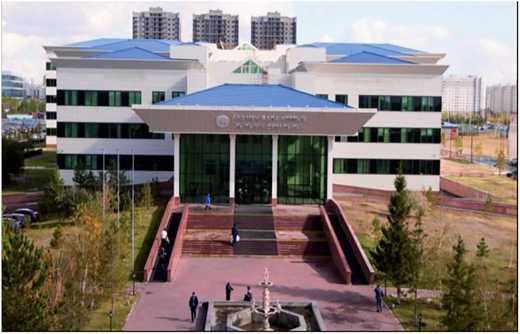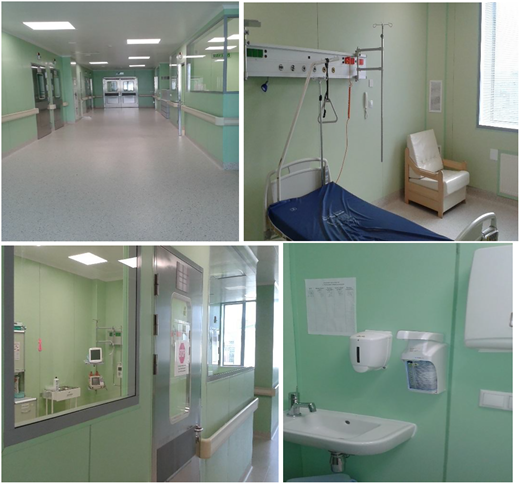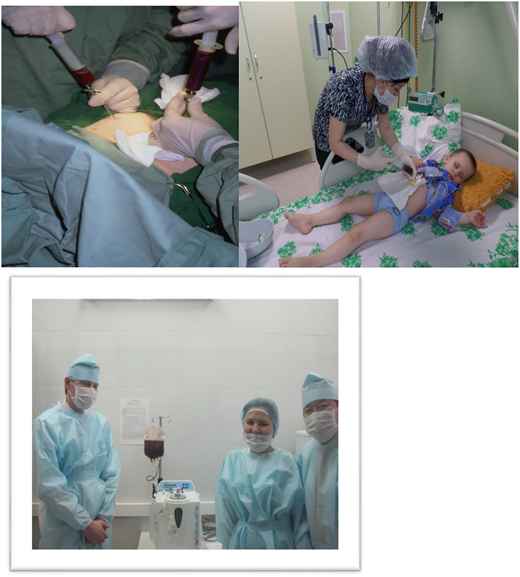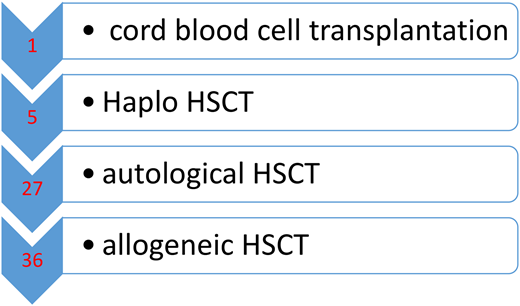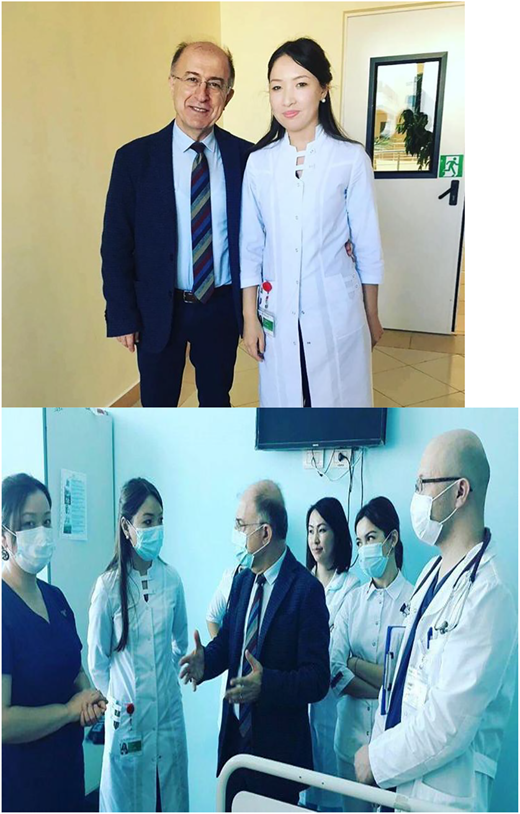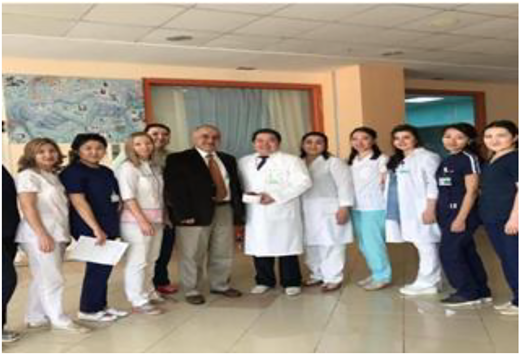Kazakhstan (officially called the Republic of Kazakhstan) is the world’s largest landlocked country, and the ninth largest country in the world, with an area of 2 724 900 km (1 052 100 square miles). Kazakhstan has an estimated 18.3 million people as of 2018. The country is divided into 14 administrative zones and has 2 major cities. Health care in Kazakhstan is provided by a network of primary, secondary, and tertiary care facilities, which are largely owned and operated by the public sector, which is represented by the Ministry of Health. Health insurance is now provided primarily by the government in the public sector. According to the latest World Health Organization data published in 2018, life expectancy in Kazakhstan is 66.8 years for men and 75.3 years for women for an average of about 71.1 years, which means that life expectancy in Kazakhstan ranks 111th in the world.
National Scientific Center for Mothers and Children (NSCMC) in Nur-Sultan
Kazakhstan is considered a developing country. Hematology service is one of our newest medical specialties, and many young medical professionals are training to be specialists in this field. There are 2 centers in Kazakhstan for treating children with oncohematologic diseases: one is in the major city of Almaty; our center is located in Nur-Sultan (formerly called Astana), the capital of Kazakhstan. Our center receives patients from the north, east, and central regions of the country. The oncology-hematology department at the NSCMC was established in 2013, and since then, our staff have focused on learning new and better techniques for treating oncohematologic patients.
NSCMC
About 600 children with cancer are registered at NSCMC annually; 60% of them have hematologic cancers and 40% have solid tumors. The most widespread type of cancer in this pediatric population is acute leukemia (34%), followed by brain tumors (16%) and neuroblastoma (nervous system tumors) (12%). Almost half the childhood cancer incidents are congenital, resulting from cells that mutated before birth. In Kazakhstan, we began conducting hematopoietic stem cell transplantations (HSCTs) in children in 2012. Every year, about 80 to 100 children in our area need HSCTs, but only 25% of them are able to locate related donors.
Until 2011, Kazakhstan did not have its own stem cell donor bank, but we were able to solve that problem with help from our Russian colleagues. A joint project was implemented within the framework of an agreement on scientific and technical cooperation between the SRI DOGIT, Pavlov First Saint Petersburg State Medical University (St. Petersburg, Russia), R. Gorbacheva Research Institute of Oncology, Hematology and Transplantation (St. Petersburg, Russia), and the Scientific Production Center оf Transfusiology (MH RK) (Nur-Sultan, Kazakhstan). The main objective of the project is to provide centralized access to a single resource staffed with professionals in the field of allogeneic bone marrow transplantation who can register donors in Russia and Kazakhstan. The opening of the Kazakhstan donor registration center contributed to the further development of oncohematologic services. Today, there are about 6000 citizens in Kazakhstan who willingly donate blood to help save the lives of sick children. The donor blood bank is replenished daily with donations from new applicants.
The first transplantation unit was opened in 2012
Being able to provide bone marrow transplantation was a breakthrough in pediatrics in Kazakhstan. A sick child’s life is difficult enough as it is, and any misstep or defect in transplantation procedures could lead to irreversible consequences. Under the direction of Dair Z. Nurgaliev (the head of NSCMC), the decision was made to send doctors from NSCMC to study at clinics in Turkey to improve their skills so they could become leaders in the field of stem cell transplantation in Kazakhstan. A team of hematologists received 3 months of advanced training under the guidance of Akif Eshelpek (a professor in Turkey). We also established strong communication ties between ourselves and Turkish doctors, so that we could contact them via Skype and ask for help with extremely difficult cases. We were able to conduct online consultations with Akif Eshelpek to discuss the results of our first bone marrow transplantations.
Conclusion
Oncohematologic service in Kazakhstan is gaining momentum and is developing more rapidly every year. We are ready and eager to continue developing our expertise in this area of medicine, because the number of patients who need oncohematologic care increases every day, especially the number of children who need stem cell transplantation. Without the help of physicians from medically advanced countries such as Turkey and Russia, we would not have been able to establish our current level of oncohematologic service in Kazakhstan.
Our plans for the future
To bring the number of hematopoietic stem cell transplantations to 30 per year, we look forward to introducing new clinical treatment protocols such as allogeneic bone marrow transplantation and chimeric antigen receptor (CAR) T-cell therapy.
National Research Center of Mother and Child Health, Nur-Sultan, Kazakhstan.
Transplantation unit with 6 hospital beds with special conditions: sterile rooms with negative air pressure.
Transplantation unit with 6 hospital beds with special conditions: sterile rooms with negative air pressure.
Process of collection, purification, and transfusion of stem cells in our center.
Process of collection, purification, and transfusion of stem cells in our center.
Discussion with Prof. Dr. Mehmet Akif Yeşilipek at the Medical Park Antalya, Istanbul.
Discussion with Prof. Dr. Mehmet Akif Yeşilipek at the Medical Park Antalya, Istanbul.
Oncohematological team of the National Research Center for Maternal and Child Health.
Oncohematological team of the National Research Center for Maternal and Child Health.
Authorship
Conflict-of-interest disclosure: The authors declare no competing financial interests.
Correspondence: Alina Ikhsanova, National Research Center of Mother and Child Health (NRCMCH), 32 Turan Ave, Nur-Sultan 010000, Kazakhstan; e-mail: ihsanova_alina@mail.ru.

